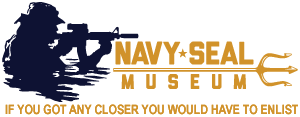Join the Harvard Club of the Palm Beaches for a
Private Tour
of the
National Navy SEAL Museum
Often called the "quiet professionals" they take on the most dangerous missions, often anonymously, and ask for nothing in return. The National Navy SEAL Museum and Memorial provide a unique view into the world and history of Naval Special Warfare and the heroes who have served.
Sunday, April 7
12:30 PM
The museum closes at 4:00 PM
 The National Navy SEAL Museum is the only museum dedicated solely to preserving the history of the United States Navy SEALs and their predecessors. Located in Fort Pierce, the Museum resides on the training grounds of the original Navy combat divers, the Frogmen.
The National Navy SEAL Museum is the only museum dedicated solely to preserving the history of the United States Navy SEALs and their predecessors. Located in Fort Pierce, the Museum resides on the training grounds of the original Navy combat divers, the Frogmen.
Built to honor the men who served with fortitude and dedication, the Navy SEAL Museum first opened its doors on Veterans Day in 1985. From humble beginnings, the facility has experienced tremendous growth, achieving national stature in 2007.
The main objective of the Museum remains the promotion of public education by providing the opportunity to explore the history of the United States Navy SEALs through interactive exhibits while honoring the fallen at the Navy SEAL Memorial and caring for those warriors’ families through the Trident House Charities Program.
The museum contains artifacts that can be seen no place else, such as the lifeboat Captain Phillips was in when Navy SEALs rescued him from Somali pirates, bullet holes, and all.
National Navy UDT-SEAL Museum
3300 N. Hwy. A1A, North Hutchinson Island
Fort Pierce, FL 34949
All sales final. No refunds.
Tickets include admission to the museum and a private tour.
Join guests before the tour at a local restaurant for brunch at 11:00 AM.
Venue TBD
(attendees will be responsible for their own tabs)
Please contact the Club Administrator for more details and to reserve your spot (HarvardClub.PB@gmail.com)
Harvard Club of the Palm Beaches Members: $15.00 per person
Regional Club Members:$15.00 per person
(Broward, Central Florida, Miami, Naples, Vero, and the HBS Club of South Florida)
The Origin of The National Navy UDT-SEAL Museum
Captain Norm Olson (SEAL), USN, RetiredIn early 1943, the Navy took over certain sections of the barrier islands off Florida’s East Coast and established the U. S. Naval Amphibious Training Base (USNATB), Fort Pierce, Florida. Training included instruction in the operation of all types of landing craft, including LSTs, LSMs, LCTs, and on down to LCVPs. Additionally, Naval Beach Battalions, Joint and later Navy Scouts & Raiders (S&Rs), and Naval Combat Demolition Units (NCDUs), the forerunners of the Underwater Demolition Teams (UDTs), were trained at this location.
As a direct result of an agreement between the Chief of Staff, the United States Army, and the Commander in Chief, the United States Fleet, the Joint Army-Navy Experimental Testing (JANET) Board was established on 2 November 1943 at USNATB. Its purpose was to coordinate service responsibilities relating to the breaching of beach and underwater obstacles incident to an amphibious landing. Projects of a Navy character were assigned to the Naval Research Demolition Unit (NRDU), and those, which were of particular interest to the Army, were assigned to the Engineer Board, Fort Pierce Project. Both conducted projects involving experimentation, development, and realistic testing of equipment and techniques.
The barrier islands at Fort Pierce, called North Beach and South Beach, were divided by a deepwater inlet that gave passage for ocean-going vessels of moderate draft to the local port facilities on the lagoon known as Indian River. South Beach, which had only a dozen or so permanent structures, became a tent city for trainees. It was here that practically all of the conventional amphibious training took place.
North Beach, a wilderness of palmettos, sand flies, and mosquitoes, became the exclusive domain of the S&Rs, NCDUs, and the JANET Board. In July 1943, the first NCDU class commenced training under the leadership of LCDR Draper L. Kauffman. In preparing for the training program, Kauffman requested the Navy S&Rs to compress their own eight-week physical training program into a single week’s schedule. It was officially called “Introduction Week,” but it has never been called anything but “Hell Week.” Kauffman and his officers went through the first “Hell Week”, establishing the precedent which still stands today that officers and enlisted men demonstrate the same capabilities and endure the same hardships. Overall attrition then was much like today, 65 to 75%.
In April 1944, CDR Kauffman considered “The Father of Demolition,” went on to command the newly formed UDT-5 in the Pacific, participating in the island campaigns of Saipan, Tinian, Pelelieu, Anguar, and the Philippines.
To assure plenty of targets for blasting by the NCDUs, Seabee Detachment 1011 on South Beach made concrete and steel duplicates of enemy underwater beach obstacles and planted them in the waters off North Beach. The cycle of Seabees fabricating obstacles and Frogmen blowing them up went on continuously until the wars end in 1945.
Before the base was closed in 1946, some 140,000 men, 3,500 of whom were NCDUs, had seen some sort of training here. After the base was closed, the area returned to normal. With the rapid post-World War II growth, there were no signs or anything else to let the tourists and new settlers know that Fort Pierce was once the site of a vital naval base during World War II.
Questions?
Contact the Club Administrator, Tricia Wansor at HarvardClub.PB@gmail.com or 954-914-3148.
